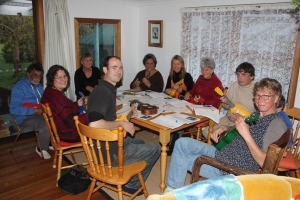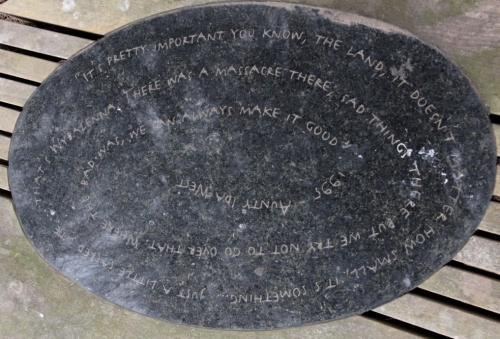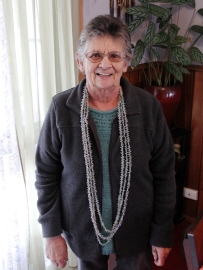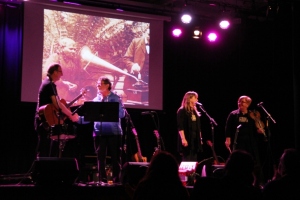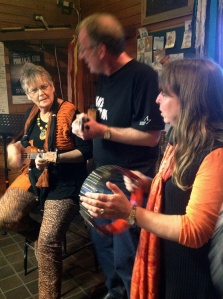Music can take you to the most surprising places.
Never would I have thought when I started strumming a guitar in Year 12 that one day itwould lead me to a stunningly beautiful, isolated island in Bass Strait.
And the wonderful thing about music is that when you go to a place like this you don’t just visit, but you are welcomed into the community and become part of it. It is a true privilege.
You get one of two reactions when you mention Flinders Island to people. It’s either “Oh wow, I’ve always wanted to go there!” or “Where’s that?” Part of its charm is that it is unknown to many. It has virtually no tourist infrastructure and most residents like it that way. So do I.
Whitemark airport must be one of the most beautiful in the world. You fly from Essendon, with its Beatles memorabilia, over Wilsons Prom and lots of little dots of islands (there are 120 named islands in Bass Strait), you come into a house-sized terminal, with Mt Strzelecki as a stunning backdrop. This ever-changing mountain dominates the south half of the island. Like a friend, like a threat, like a god.
I first became conscious of Flinders Island when I was writing my song The Man and the Woman and the Edison Photograph, about my great grandfather Horace Watson recording Fanny Cochrane Smith, who claimed to be the last Tasmanian. She was born a Wybalenna on Flinders Island where Tasmania’s Aboriginal population were settled in the 1830s.
That song has taken me on an amazing journey: hearing my great grandfather’s voice across 100 years, meeting descendents of Fanny Cochrane Smith, and more. And now it was at the heart of this physical journey. Ronnie Summers is a talented and respected elder who was born on Flinders Island, and raised on Cape Barren Island (next to Flinders), and grew up playing the unique local style of music, derived from the sealers who dominated Bass Strait in the 1800s. He is Fanny Cochrane Smith’s great great great grandson. We met through my song, and have performed it together on some memorable occasions. (There’s more background on this story here) Ronnie and his wife Dyan have recently moved back to Flinders.
Jenny Drake saw the Unsung Heroes of Australian History show at the Cygnet Folk Festival in Tasmania in 2012 and said we should take it to Flinders Island, where she was about to move to. I couldn’t let the idea go. Not only did I know Jenny, Ronnie and Dyan, but I also know jazz singer Judy Jacques, who had also just moved to the island with her husband Sandro. After some to-ing and fro-ing, the island’s regional arts council agreed to support a trip there.
From the moment we arrived we felt like part of the community. Sandro was on the tiny plane with us, and the delightful Sally Walker from the Regional Arts Council met us at the airport and lent us her Mitsubishi 4WD ute. Sally is 6th generation Flinders Island, and her family own the islands only supermarket and garage. Her dad Leedham Walker is an island institution who flies his light plane to Gippsland every week to get fresh vegetables for the shop. Such a pity the clutch went on the Mitsubishi – not that we blame Wendy for that!
Dyan had us over to her place for afternoon tea in a trice! In fact we ate three times with Dyan and Ronnie and the various young family members, and had the honour of meeting elders Aunty Vicky, Aunty Colleen and Aunty B. Between them they are masters of traditional women’s craft, including shell necklaces, and baskets made from flax and bull kelp. And they were delightful company. Dyan fed us so well, including a special meal of muttonbird. The annual muttonbirding has been an important traditional island activity for Aboriginal people, for a very long time. Ronnie and Dyan have done it since childhood. You have to stick your hand down a hole and hope you don’t find a snake instead. The smell of cooked muttonbird is a bit overpowering, but the taste is pretty good, especially with Dyan’s damper and special sauce.
We also met a lot of the community through our music activities. We had such fun working with the local acapella group, led by the irrepressible Kathleen. They learned choral arrangements specially prepared by Wendy for two of the shows songs, and what a brilliant job they did.
Another joyous musical activity we led was a ukulele workshop. We had a great time doing what I call “Ukulele for beginners, with songs that don’t suck.” People had so much fun that there was talk of getting a uke group going. They may have help from the mythical Butter Factory Boys, a co-op who make ukuleles at the old butter factory. Unfortunately they were off the island at the time.
And then there was Scottish Country Dancing – a Thursday night tradition on the island for 30 years, led by the redoubtable doyenne of dance Lady Mary MacTier. She is reputedly a real Lady, but no-one quite knows the details of her past. Just enough mystery to make her fascinating. She runs a tight ship, and fun is had by all. The thing is, Lady Mary is 99 years old! She didn’t dance, but she spent a good deal of the night standing up ordering us about.
The school community is part of the heart of Flinders Island, with fabulous facilities and a lot of very dedicated staff and helpers, including Sandro who tends the schools olive grove, and John the Juggler who helps the kids make djembes out of papier maché and wallaby skin from roadkill (more about roadkill later). The school is Prep to Year 10, with almost 80 students.Wendy and I did a school version of the Unsung Heroes show, plus a very fun time doing some silly songs with the littlies.
The wildlife, including birdlife, is fantastic, as you might expect with such a fertile climate and so few people – and no rabbits or foxes – but a few wild cats. But back to roadkill. So, there are about 800 people on the island and 17 million wallabies! Consequently, when you drive on the roads you only see another car every several kilometers. But it’s hard to go 100 meters without seeing an ex-wallaby, and occasionally ex-wombat. So few cars, so much roadkill! Driving at night is extremely hazardous and to be avoided if possible.
There is one piece of graffiti on the island: a huge boulder by the roadside is marked with the message: LOVE LIFE.
Life is slow. The few shops there are close at 5pm every night, including Friday, and nothing is open between midday Saturday till Monday morning. On Saturday mornings the bakery (beautiful wallaby pies!) and Freckles, the island’s only café, across the road open alternate weeks. This same pattern is repeated over the island where businesses cooperate rather than compete to ensure that everyone gets a slice of the (wallaby) pie.
As well as all our musical activities and socializing, it was also wonderful to have the luxury of time to do a little bit of touring. The island is full of places with great names such as: Fotheringate Beach, Palana, Tin Kettle Island, Badger Island, Big Green Island, Little Green Island, Killiecrankie, Trousers Point (don’t ask) and Lady Baron. And the local language includes a few different words mostly derived from the early sealers, such as ‘badger’ for wombat and ‘porcupine’ for echidna, as well as ‘diamond’ for topaz, found on the north coast.
Wybalenna is a very sad place. Tasmania’s remaining Aboriginal people were settled there by George Augustus Robinson in 1834 to be ‘civilised and christianised’. They were forbidden to practise their old ways and were homesick for their lost country. In a very few years over 100 died there of respiratory disease, poor food and despair.
All that stands there now is the reconstructed chapel and the cemetery. In the cemetery the Tasmanians’ graves are not marked, although there are a couple of memorial plaques. They were buried outside the fence and unidentified, some remains were stolen for ‘science’. There are a number of European people’s graves.
Wybalenna is one of the most important historical sites in the country, but there are no markers of this importance. It is now Aboriginal land, and some in the community want to make it a place of memory. Others just want to forget. Aunty Ida West was one who felt passionately that it is important to remember. Next to the chapel under a large tree is a table with a beautifully carved stone carrying her message: It’s pretty important you know, the land, it doesn’t matter how small, it’s something, just a little sacred site, that’s Wybalenna. There was a massacre there, sad things there, but we try not to go over that. Where the bad was we can always make it good.
But there are many happy places to visit. The Furneaux museum at Emita is run by another local hero, D’reen Lovegrove. It’s full of quirky aspects of the islands’ history as well as having a fabulous archive for research purposes.
There are so many beautiful beaches and bays. You’re almost guaranteed to be the only one on the beach. The wind may be pounding in at you or it may be calm and sunny, but it’s always beautiful. There are granite mountains above and rocks and builders with orange lichen. There are wild, uninhabited islands out to sea, there are seabirds, and there may be a lighthouse.
Killiecrankie beach is my favourite, with Mt Killiecrankie dominating, cray pots stacked on the foreshore, and fishing boats moored in the bay. Beautiful light, beautiful colours. A handful of people live there, and a few dozen more come in over the summer holidays – and most of them are from the south of Flinders Island!

We visited Judy and Sandro at their bush cottage near Killiecrankie. They fed us like royalty, with much of the food home grown.
Lady Barron is another stunningly beautiful spot, looking out over the Franklin Sound towards Cape Barren Island and a number of smaller islands. We were privileged to visit Aunty B (Bernice Condie), shell necklace maker, who lives there. Necklace-making is a Palawa tradition that has remained intact and has continued without interruption since before European settlement (see article). She explained to us the incredibly long and slow process of collecting and preparing the shells, and of individually drilling and stringing the necklaces, which have thousands of maireener shells.
Neil and I decided to climb all 782 meters of Mt Strzelecki before our Sunday gig. So we had to start early and push hard. It’s a serious climb. The views were fabulous – till we got right to the top, when the clouds came in. And we proved our manhood!
But of course, we were there to play music, and what fun we had! At the main concert at the Whitemark community hall we had about 10% of the island’s population! It was such a joy to share the stage with the acapella group, and of course Ronnie Summers. How moving for us to sing ‘our’ song actually on Flinders Island. We have been told that there is a bit of racism on the island, and were thrilled to be told that that performance opened a few eyes. We certainly know it brought Ronnie and his story to the attention of a lot of people who didn’t know it. If it helps build connections, I would be thrilled. Anyway, on top of all that, we received a standing ovation. It was one of those evenings I will certainly remember all my life.
The other major musical event was an afternoon at the Lady Barron Tavern, with its to-die-for view. It was a real community affair, put together as a fundraiser for David Williams’ amazing Launceston-Hobart run to raise funds for cancer research. We raised quite a bit through donations and an auction, very skillfully conducted by Neil. But the highlight was the wonderful mix-and match musical items which had Ronnie singing some old Cape Barren songs backed by a scratch band, Judy singing for the first time in ages due to a nagging sickness she has had, Sandro belting it out on trumpet, the UHAH mob doing various bits and pieces joined by these various people and the acapella group. This was community music as it should be, and the afternoon flew by.
It felt like leaving home when we finally got on the plane back to Melbourne. But I reckon I’ll be back – by hook or by crook.
You can view more photos of the trip on the Unsung Heroes of Australian History Facebook page







